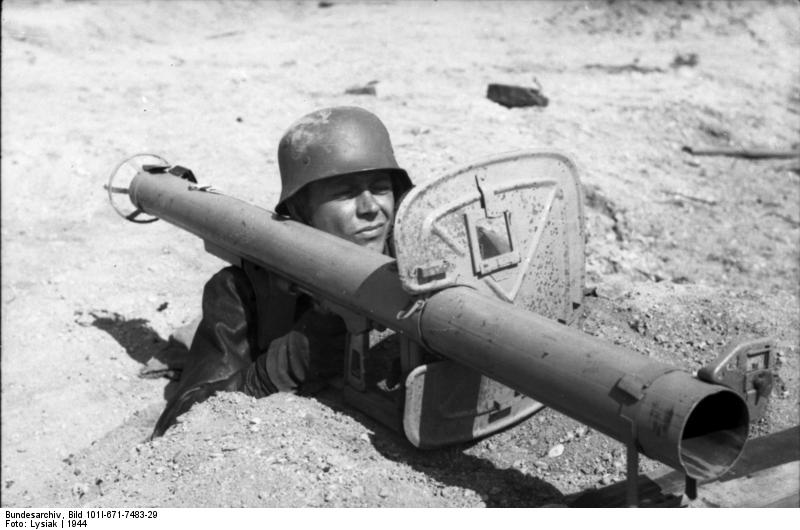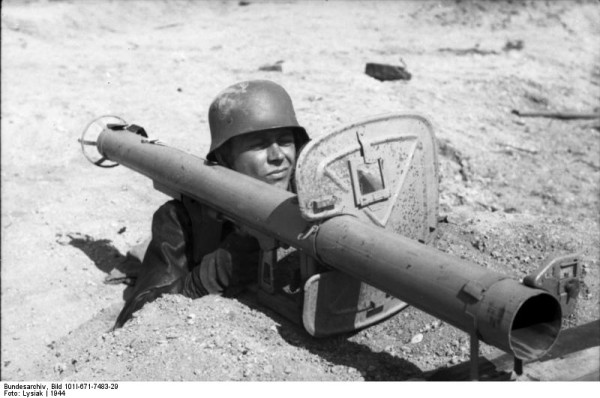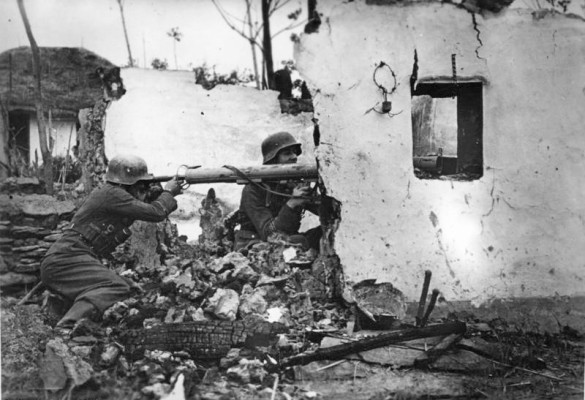When the starting shot rang out, the athletes surged forward. Jesse Owens dug his spikes deep into the racing track of Berlin’s Olympic Stadium — and the best sprinter of his day dominated the 100 meters race to win a gold medal at the 1936 Olympic Games. America’s black superstar took home a total of four gold medals.
And each of his victories represented minor triumphs for two German brothers as well – Adolf (“Adi”) and Rudolf Dassler – the manufacturers of the sprinting shoes that carried the sprinter of the century from victory to victory.
But the history of the Dasslers – who both joined the Nazi Party in 1933 – wouldn’t be complete without one chapter from World War II: In 1944, there was suddenly a spike in the number of Allied tanks being blown apart by German fire. The culprit was the latest anti-tank rocket launcher, nicknamed the “Panzerschreck” (“Tank Terror”). This extremely effective weapon petrified Allied tank crews — and it was manufactured in the same factory that had developed Owens’ shoes only eight years earlier.
Welding Replaces Stitching
This little-known excursion into the war industry by the two famous shoemakers was hardly an isolated case. Hitler’s regime used many small and medium-sized companies to produce military equipment and armaments. “For the ‘total war’ proclaimed by Goebbels in early 1943, the Nazis needed a total war economy,” explains Lutz Budrass, a business historian at the University of Bochum.
Similar things were happening all across the country — and German industry increasingly resembled one big military machine. The Hugo Boss textile factory, for example, in the southern German town of Metzingen, was also a military supplier. Beginning in late 1944, instead of suits and leather jackets, workers on the production floors of the future fashion czar were making ball bearings.
Germany’s flagship airline Lufthansa manufactured radar equipment for the Luftwaffe, Germany’s air force, and furniture companies made parts for fighter jets like the Heinkel He 162, one of the first military jets in the world. Given the scarcity of metal, the jet was primarily made of wood.
Four years into World War II, not much Olympic glory was left among the shoemakers of Herzogenaurach. The German army was on the retreat on virtually all fronts, bombs were raining down on German cities and resources were running short.
December 1943 marked the final blow for the town’s shoe production. Hitler’s regime ordered a halt to all civilian business operations, and the shoe-making machines in the Dassler Brothers’ production hall were replaced with spot-welding equipment for making weapons. Before long, nearly everyone in Herzogenaurach was working for the military. The local lederhosen factory stopped making the traditional Bavarian leather shorts and, instead, started producing bread bags and rucksacks for soldiers. A nearby family business made torpedo parts for the navy.
The Panzerschreck was designed as a lightweight infantry anti-tank weapon. The weapon was shoulder-launched and fired a fin-stabilized rocket with a shaped-charge warhead.
It was made in smaller numbers than the Panzerfaust, which was a disposable recoilless rifle firing an anti-tank warhead. It was an enlarged copy of the American bazooka; however, it also used pre existing German technology with development of similar weapons beginning before the American bazooka was encountered.
The Panzerschreck was developed as a copy from captured bazookas of American origin. They were either captured in 1942 on the Eastern front from Soviet forces that had received a shipment of bazookas or they were captured in Tunisia from American forces in February 1943. The American bazookas also spurred the development of the Faustpatrone and successor Panzerfaust anti-tank grenade launchers that each also used a HEAT warhead.
The Panzerschreck was larger and heavier than its American counterpart – the Panzerschreck had an 88 mm calibre, compared to the 60 mm calibre of the bazooka, which meant that it could penetrate thicker armor, but it also produced more smoke when firing.
The Panzerschreck could penetrate 100 mm of armor using early war rockets, and 160 mm of armor with rockets developed later in the war, for which the blast shield of the RPzB 54 was necessary. Late war German tactical doctrine called for Panzerschreck and/or Panzerfaust teams to set up in staggered trenches no further than 115 metres apart. In this way, attacking armor would face anti-tank fire from multiple directions at a distance of no more than 69 metres. Anti-tank teams were instructed to aim for the thinner side or rear armor whenever possible.
Allied armored units frequently attempted to add improvised protection to their tanks, e.g. sandbags, spare track units, logs and so on to protect against HEAT rounds. Most of this makeshift protection had little effect, and overtaxed the vehicle’s engine, transmission, and suspension systems. Another defense was to rig metal mesh and netting around the tank, resembling the German Schürzen auxiliary plates.
The Panzerschreck’s combat success caused the Bazooka to be completely redesigned at the close of World War II. A larger, 90 mm (3.5 in) model was adopted; hence, the M20 Super Bazooka. Though bearing a superficial resemblance to the Panzerschreck, the M20 had greater effective range, penetrating capability, and was nearly 20% lighter than its former counterpart.
In 1944, Germany provided the Panzerschreck to Finland, who used it to great effect against Soviet armour. The Finnish name for the weapon was Panssarinkauhu (literal translation of the German name). An all-new Finnish weapon, the 55 S 55, was developed after the war along the lines of Panzerschreck.


